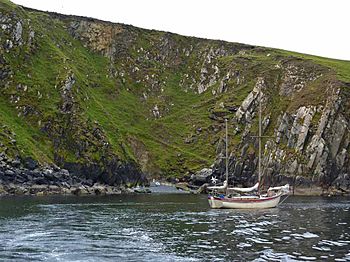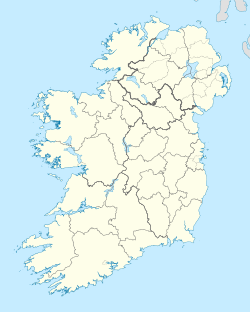Inishvickillane facts for kids
|
Native name:
Inis Mhic Aoibhleáin
|
|
|---|---|
 |
|
| Geography | |
| Location | Atlantic Ocean |
| Coordinates | 52°02′37″N 10°36′30″W / 52.04350°N 10.60829°W |
| Archipelago | Blasket Islands |
| Highest elevation | 200 m (700 ft) |
| Administration | |
|
Ireland
|
|
| Province | Munster |
| County | County Kerry |
| Demographics | |
| Population | 0 (0) |
| Pop. density | 0 /km2 (0 /sq mi) |
| Inishvickillane | |
|---|---|
| Highest point | |
| Elevation | 135 m (443 ft) |
| Prominence | 135 m (443 ft) |
| Dimensions | |
| Area | 0.692 km2 (0.267 sq mi) |
| Geography | |
| OSI/OSNI grid | V211911 |
Inishvickillane, also called Inishvickillaun, is a small island off the coast of County Kerry, Ireland. Its name in Irish, Inis Mhic Aoibhleáin, means 'Mac Killane's island'. It is one of the beautiful Blasket Islands, a group of islands known for their stunning scenery and rich history.
Contents
Exploring Inishvickillane's Past
Ancient Settlements and History
People from the Blasket Islands often called Inishvickillane "The Inis." Families lived on this island off and on during the 1800s and early 1900s.
The island has many old stone buildings that are very important to archaeologists. For example, on the southeast side of Inishvickillane, you can find the remains of a very old monastery. This site includes:
- A dry-stone oratory (a small chapel for prayer).
- A graveyard.
- A leacht with a stone cross (a type of altar or monument).
- What might be a clochán (a beehive-shaped stone hut).
- A holy well dedicated to St. Brendan.
The south wall of the oratory once had a special stone with an old inscription. It said: "A prayer for Mac-Ruaid, grandson of Dálach."
The Mystery of the Ogham Stone
In 1902, some newspapers reported that this special stone, an Ogham stone, was stolen from the island. Ogham is an ancient Irish alphabet, usually carved into stone. It turned out the stone wasn't stolen; it was taken to Trinity College Dublin for study. It is still there today.
Inishvickillane is sometimes called "the last parish before America." This means it's one of the most western pieces of land in Europe. Because of its location, it will be the first place in Europe to see the solar eclipse on September 23, 2090.
Charles Haughey and the Island
A Famous Purchase
In the early 1970s, the area around West Kerry became more popular with tourists. This was partly because of the movie Ryan's Daughter. In 1974, a man named Charles J Haughey bought Inishvickillane. He was a well-known Irish politician who later became the Taoiseach (Prime Minister) of Ireland.
Newspapers reported that Mr. Haughey bought the island as a summer home for his family. The island used to belong to the O Dalaigh family. All that was left of their old home was a stone cabin. The O Dalaigh family still used the island to graze their sheep in the summer. Mr. Haughey planned to build a new house but wanted to keep the island's natural beauty.
Public Interest and National Park Plans
Mr. Haughey's purchase of the island got a lot of attention. People talked about how wealthy he was and how smart he was with business, as land in the area was becoming more valuable. They also discussed his interest in Irish heritage.
Later, in 1989, when Haughey was Taoiseach, he tried to make the Blasket Islands a national park. This would have given the government the power to buy land on the islands, even if the owners didn't want to sell. However, in 1998, a judge ruled that this plan was against the constitution.
Old government papers from 1989 showed that the Irish Naval Service and Irish Air Corps had a detailed plan. This plan was to quickly get Haughey off the remote island if there was an emergency that needed him for government work.
Geography of Inishvickillane
Inishvickillane is one of the most western parts of Ireland. Only Tearaght Island and a few rocks are further west. Inishvickillane is likely the most western part of Ireland that had regular people living on it. Tearaght Island only had lighthouse keepers before the lighthouse became automatic in 1988.
A writer named Robin Flower noted something interesting about the island's soil. The people who lived there said the soil was too rich for potatoes. However, it was good for growing cabbage and onions. There was even a story that tobacco was successfully grown there once!
Nature and Wildlife
Inishvickillane is a very important place for seabird colonies. Many different kinds of seabirds live and nest here. It is especially known for:
- Northern fulmar (a type of seabird similar to a gull).
- European storm petrel (a small seabird that flies close to the water).
- Atlantic puffin (a colorful seabird with a distinctive beak).
A herd of red deer was also brought to the island by Charles Haughey.


